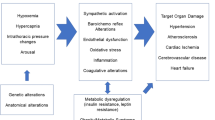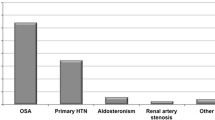Abstract
Obstructive sleep apnea (OSA) is a recognized cause of secondary hypertension. OSA episodes produce surges in systolic and diastolic pressure that keep mean blood pressure levels elevated at night. In many patients, blood pressure remains elevated during the daytime, when breathing is normal. Contributors to this diurnal pattern of hypertension include sympathetic nervous system overactivity and alterations in vascular function and structure caused by oxidant stress and inflammation. Treatment of OSA with nasal continuous positive airway pressure (CPAP) abolishes apneas, thereby preventing intermittent arterial pressure surges and restoring the nocturnal “dipping” pattern. CPAP treatment also has modest beneficial effects on daytime blood pressure. Because even small decreases in arterial pressure can contribute to reducing cardiovascular risk, screening for OSA is an essential element of evaluating patients with hypertension.
Similar content being viewed by others
References and Recommended Reading
Young T, Palta M, Dempsey J, et al.: The occurrence of sleep-disordered breathing among middle-aged adults. N Engl J Med 1993, 328:1230–1235.
Peppard PE, Young T, Palta M, et al.: Prospective study of the association between sleep-disordered breathing and hypertension. N Engl J Med 2000, 342:1378–1384.
Fletcher EC: Invited review: physiological consequences of intermittent hypoxia: systemic blood pressure. J Appl Physiol 2001, 90:1600–1605.
Becker HF, Jerrentrup A, Ploch T, et al.: Effect of nasal continuous positive airway pressure treatment on blood pressure in patients with obstructive sleep apnea. Circulation 2003, 107:68–73.
Narkiewicz K, van de Borne PJ, Montano N, et al.: Contribution of tonic chemoreflex activation to sympathetic activity and blood pressure in patients with obstructive sleep apnea. Circulation 1998, 97:943–945.
Prabhakar NR, Peng YJ, Jacono FJ, et al.: Cardiovascular alterations by chronic intermittent hypoxia: importance of carotid body chemoreflexes. Clin Exp Pharmacol Physiol 2005, 32:447–449.
Lam SY, Fung ML, Leung PS: Regulation of the angiotensin-converting enzyme activity by a time-course hypoxia in the carotid body. J Appl Physiol 2004, 96:809–813.
Moller DS, Lind P, Strunge B, et al.: Abnormal vasoactive hormones and 24-hour blood pressure in obstructive sleep apnea. Am J Hypertens 2003, 16:274–280.
Peng YJ, Overholt JL, Kline D, et al.: Induction of sensory long-term facilitation in the carotid body by intermittent hypoxia: implications for recurrent apneas. Proc Natl Acad Sci USA 2003, 100:10073–10078.
Chen J, He L, Dinger B, et al.: Role of endothelin and endothelin A-type receptor in adaptation of the carotid body to chronic hypoxia. Am J Physiol Lung Cell Mol Physiol 2002, 282:L1314–L1323.
Grimpen F, Kanne P, Schulz E, et al.: Endothelin-1 plasma levels are not elevated in patients with obstructive sleep apnoea. Eur Respir J 2000, 15:320–325.
Gjorup PH, Sadauskiene L, Wessels J, et al.: Abnormally increased endothelin-1 in plasma during the night in obstructive sleep apnea: relation to blood pressure and severity of disease. Am J Hypertens 2007, 20:44–52.
Sun SY, Wang W, Zucker IH, et al.: Enhanced activity of carotid body chemoreceptors in rabbits with heart failure: role of nitric oxide. J Appl Physiol 1999, 86:1273–1282.
Weiss JW, Liu MD, Huang J: Sleep apnoea and hypertension: physiological bases for a causal relation: physiological basis for a causal relationship of obstructive sleep apnoea to hypertension. Exp Physiol 2007, 92:21–26.
Zimmerman MC, Lazartigues E, Lang JA, et al.: Superoxide mediates the actions of angiotensin II in the central nervous system. Circ Res 2002, 91:1038–1045.
Zucker IH: Brain angiotensin II: new insights into its role in sympathetic regulation. Circ Res 2002, 90:503–505.
Huang J, Tamisier R, Ji E, et al.: Chronic intermittent hypoxia modulates nNOS mRNA and protein expression in the rat hypothalamus. Respir Physiol Neurobiol 2007, 158:30–38.
Phillips SA, Olson EB, Morgan BJ, et al.: Chronic intermittent hypoxia impairs endothelium-dependent dilation in rat cerebral and skeletal muscle resistance arteries. Am J Physiol Heart Circ Physiol 2004, 286:H388–H393.
El Solh AA, Saliba R, Bosinski T, et al.: Allopurinol improves endothelial function in sleep apnoea: a randomised controlled study. Eur Respir J 2006, 27:997–1002.
Grebe M, Eisele HJ, Weissmann N, et al.: Antioxidant vitamin C improves endothelial function in obstructive sleep apnea. Am J Respir Crit Care Med 2006, 173:897–901.
Lattimore JL, Wilcox I, Skilton M, et al.: Treatment of obstructive sleep apnoea leads to improved microvascular endothelial function in the systemic circulation. Thorax 2006, 61:491–495.
Ip MS, Lam B, Chan LY, et al.: Circulating nitric oxide is suppressed in obstructive sleep apnea and is reversed by nasal continuous positive airway pressure. Am J Respir Crit Care Med 2000, 162:2166–2171.
Schulz R, Mahmoudi S, Hattar K, et al.: Enhanced release of superoxide from polymorphonuclear neutrophils in obstructive sleep apnea. Impact of continuous positive airway pressure therapy. Am J Respir Crit Care Med 2000, 162:566–570.
Wolk R, Svatikova A, Otto ME, et al.: Plasma adrenomedullin and obstructive sleep apnea. Am J Hypertens 2004, 17:74–76.
Schulz R, Flototto C, Jahn A, et al.: Circulating adrenomedullin in obstructive sleep apnoea. J Sleep Res 2006, 15:89–95.
Yamamoto H, Teramoto S, Yamaguchi Y, et al.: Long-term oxygen administration reduces plasma adrenomedullin levels in patients with obstructive sleep apnea syndrome. Sleep Med 2007, In press.
Pratt-Ubunama MN, Nishizaka MK, Boedefeld RL, et al.: Plasma aldosterone is related to severity of obstructive sleep apnea in subjects with resistant hypertension. Chest 2007, 131:453–459.
Tanriverdi H, Evrengul H, Kara CO, et al.: Aortic stiffness, flow-mediated dilatation and carotid intima-media thickness in obstructive sleep apnea: non-invasive indicators of atherosclerosis. Respiration 2006, 73:741–750.
Phillips C, Hedner J, Berend N, et al.: Diurnal and obstructive sleep apnea influences on arterial stiffness and central blood pressure in men. Sleep 2005, 28:604–609.
Drager LF, Bortolotto LA, Figueiredo AC, et al.: Obstructive sleep apnea, hypertension, and their interaction on arterial stiffness and heart remodeling. Chest 2007, 131:1379–1386.
Yokoe T, Minoguchi K, Matsuo H, et al.: Elevated levels of C-reactive protein and interleukin-6 in patients with obstructive sleep apnea syndrome are decreased by nasal continuous positive airway pressure. Circulation 2003, 107:1129–1134.
Gonzalez NC, Allen J, Schmidt EJ, et al.: Role of the renin-angiotensin system in the systemic microvascular inflammation of alveolar hypoxia. Am J Physiol Heart Circ Physiol 2007, 292:H2285–H2294.
Zhao Q, Ishibashi M, Hiasa K, et al.: Essential role of vascular endothelial growth factor in angiotensin II-induced vascular inflammation and remodeling. Hypertension 2004, 44:264–270.
Allahdadi KJ, Walker BR, Kanagy NL: Augmented endothelin vasoconstriction in intermittent hypoxia-induced hypertension. Hypertension 2005, 45:705–709.
Palma BD, Gabriel A Jr, Bignotto M, et al.: Paradoxical sleep deprivation increases plasma endothelin levels. Braz J Med Biol Res 2002, 35:75–79.
Zhang J, Zhao B, Gesongluobu, et al.: Angiotensin-converting enzyme gene insertion/deletion (I/D) polymorphism in hypertensive patients with different degrees of obstructive sleep apnea. Hypertens Res 2000, 23:407–411.
Bostrom KB, Hedner J, Melander O, et al.: Interaction between the angiotensin-converting enzyme gene insertion/deletion polymorphism and obstructive sleep apnoea as a mechanism for hypertension. J Hypertens 2007, 25:779–783.
Patel SR, Emma KL, Mignot E, et al.: The association of angiotensin converting enzyme (ACE) polymorphisms with sleep apnea and hypertension. Sleep 2007, 30:531–533.
Sjostrom C, Lindberg E, Elmasry A, et al.: Prevalence of sleep apnoea and snoring in hypertensive men: a population based study. Thorax 2002, 57:602–607.
Netzer NC, Stoohs RA, Netzer CM, et al.: Using the Berlin Questionnaire to identify patients at risk for the sleep apnea syndrome. Ann Intern Med 1999, 131:485–491.
Calhoun DA, Nishizaka MK, Zaman MA, et al.: Hyperaldosteronism among black and white subjects with resistant hypertension. Hypertension 2002, 40:892–896.
Amin RS, Carroll JL, Jeffries JL, et al.: Twenty-four-hour ambulatory blood pressure in children with sleep-disordered breathing. Am J Respir Crit Care Med 2004, 169:950–956.
Leung LC, Ng DK, Lau MW, et al.: Twenty-four-hour ambulatory BP in snoring children with obstructive sleep apnea syndrome. Chest 2006, 130:1009–1017.
Zintzaras E, Kaditis AG: Sleep-disordered breathing and blood pressure in children: a meta-analysis. Arch Pediatr Adolesc Med 2007, 161:172–178.
Heitmann J, Ehlenz K, Penzel T, et al.: Sympathetic activity is reduced by nCPAP in hypertensive obstructive sleep apnoea patients. Eur Respir J 2004, 23:255–262.
Norman D, Loredo JS, Nelesen RA, et al.: Effects of continuous positive airway pressure versus supplemental oxygen on 24-hour ambulatory blood pressure. Hypertension 2006, 47:840–845.
Robinson GV, Smith DM, Langford BA, et al.: Continuous positive airway pressure does not reduce blood pressure in nonsleepy hypertensive OSA patients. Eur Respir J 2006, 27:1229–1235.
Campos-Rodriguez F, Grilo-Reina A, Perez-Ronchel J, et al.: Effect of continuous positive airway pressure on ambulatory BP in patients with sleep apnea and hypertension: a placebo-controlled trial. Chest 2006, 129:1459–1467.
Alajmi M, Mulgrew AT, Fox J, et al.: Impact of continuous positive airway pressure therapy on blood pressure in patients with obstructive sleep apnea hypopnea: a meta-analysis of randomized controlled trials. Lung 2007, 185:67–72.
Bazzano LA, Khan Z, Reynolds K, et al.: Effect of nocturnal nasal continuous positive airway pressure on blood pressure in obstructive sleep apnea. Hypertension 2007, 50:417–423.
Haentjens P, Van Meerhaeghe A, Moscariello A, et al.: The impact of continuous positive airway pressure on blood pressure in patients with obstructive sleep apnea syndrome: evidence from a meta-analysis of placebo-controlled randomized trials. Arch Intern Med 2007, 167:757–764.
Martinez-Garcia MA, Gomez-Aldaravi R, Soler-Cataluna JJ, et al.: Positive effect of CPAP treatment on the control of difficult-to-treat hypertension. Eur Respir J 2007, 29:951–957.
Morgan BJ, Dempsey JA, Pegelow DF, et al.: Blood pressure perturbations caused by subclinical sleep-disordered breathing. Sleep 1998, 21:737–746.
Marin JM, Carrizo SJ, Vicente E, et al.: Long-term cardiovascular outcomes in men with obstructive sleep apnoea-hypopnoea with or without treatment with continuous positive airway pressure: an observational study. Lancet 2005, 365:1046–1053.
Gotsopoulos H, Kelly JJ, Cistulli PA: Oral appliance therapy reduces blood pressure in obstructive sleep apnea: a randomized, controlled trial. Sleep 2004, 27:934–941.
Author information
Authors and Affiliations
Corresponding author
Rights and permissions
About this article
Cite this article
Dopp, J.M., Reichmuth, K.J. & Morgan, B.J. Obstructive sleep apnea and hypertension: Mechanisms, evaluation, and management. Current Science Inc 9, 529–534 (2007). https://doi.org/10.1007/s11906-007-0095-2
Published:
Issue Date:
DOI: https://doi.org/10.1007/s11906-007-0095-2




